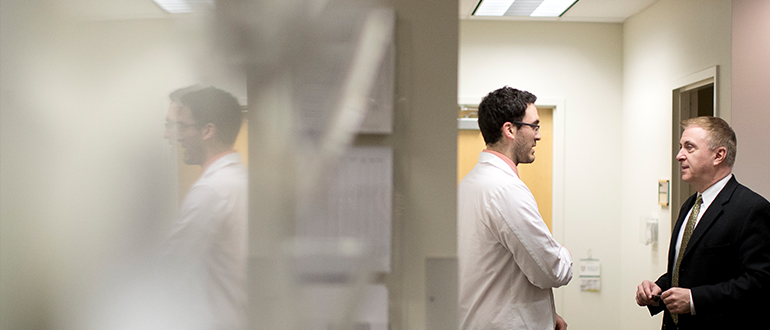
Pennsylvania College of Optometry Strategic Plan 2021-2026
MISSION
The Pennsylvania College of Optometry innovates and leads in the development of Doctors of Optometry who advance health and health care through excellence in discovery, patient care, and professional leadership.
VISION
The Pennsylvania College of Optometry will be recognized as an innovator in providing optometric education with emphasis on an interdisciplinary approach to healthcare.
Program Goals
Objectives:
Goal 2: Implement and assess a progressive curriculum that prepares students to provide state of the art optometric care.
Objectives:
Goal 3: Develop an enrollment management plan for PCO programs (traditional, scholars, APOD).
Objectives:
Goal 4: Strengthen student learning outcome assessment strategies, analyses, and appropriate interventions for the Traditional, Accelerated Scholars, and Advanced Placement in Optometry Degree programs.
Objectives:
Goal 5: Develop graduates who are life-long learners trained to practice full scope optometry with a diverse patient base and in a variety of healthcare settings.
Objectives:
Goal 6: Maintain full accreditation by the Accreditation Council on Optometric Education (Next self-study 2024/2025).
Objectives:
Goal 7: Develop innovative models for optometric education that reflect the changing healthcare and educational landscape.
Objectives:
Goal 8: Coordinate with other Salus programs (i.e., OT, AuD) to develop and implement models for interprofessional collaborative care.
Objectives:
Goal 1: Recruit, develop, and retain highly qualified and diverse faculty best-suited to deliver the curriculum.
Objectives:
- 1.1 Conduct faculty salary and FTE analysis by department to align with the needs of our optimal, sustainable traditional class size.
- 1.2 Develop and maintain faculty leaders in academic and programmatic assessment.
- 1.3 Increase faculty awareness of educational pedagogy, innovative teaching options, and technological resources.
- 1.4 Support and promote lifelong learning and growth opportunities that cultivate leadership, discovery, and scholarly activity.
- 1.5 Assess and identify needs for basic science and clinical research faculty support and recruitment.
- 1.6 Strengthen faculty recruitment by expanding the basic science and clinical faculty applicant pool and refine the committee process through the use of documented best practices in the recruitment of faculty with a) diverse backgrounds and b) content knowledge and skills c) clinical expertise.
Goal 2: Implement and assess a progressive curriculum that prepares students to provide state of the art optometric care.
Objectives:
- 2.1 Engage Curriculum Committee members including Chair, Sub-Committee Chairs, and Committee Members, in continued curriculum review processes.
- 2.2 Initiate curriculum mapping to identify gaps, redundancies, and areas of potential expanded instruction.
- 2.3 Revise and implement curricular modifications according to evaluation of assessment results.
- 2.4 Continue and strengthen innovative educational TLS resources for increasing efficiency in student learning and assessment.
Goal 3: Develop an enrollment management plan for PCO programs (traditional, scholars, APOD).
Objectives:
- 3.1 Establish an optimum, sustainable class size for the PCO didactic and clinical program.
- 3.2 Evaluate the recruitment model for the Accelerated Scholars Program and determine strategies to increase the number of qualified candidates completing applications.
- 3.3 Develop a sustainable model for implementing and assessing the Advanced Placement Optometry Degree (APOD) program.
Goal 4: Strengthen student learning outcome assessment strategies, analyses, and appropriate interventions for the Traditional, Accelerated Scholars, and Advanced Placement in Optometry Degree programs.
Objectives:
- 4.1 Assess the scope and quality of the didactic educational experience.
- 4.2 Assess the scope and quality of the on-campus clinical educational experience.
- 4.3 Assess the scope and quality of the off-site externship program experience.
- 4.4 Assess scope and quality of the Advanced Studies experience.
Goal 5: Develop graduates who are life-long learners trained to practice full scope optometry with a diverse patient base and in a variety of healthcare settings.
Objectives:
- 5.1 Provide students with diverse clinical experiences during their internship and externship.
- 5.2 Implement laser/minor surgical curricular content and build a lasers suite within PCO.
- 5.3 Improve first time pass rate for all parts of NBEO testing.
Goal 6: Maintain full accreditation by the Accreditation Council on Optometric Education (Next self-study 2024/2025).
Objectives:
- 6.1 Identify Self-Study Committee including Co-Chairs, Standard Chair’s, Committee Members, and University contacts.
- 6.2 Engage faculty in the self-study process.
- 6.3 Develop a self-study document in preparation for 2024/2025 ACOE Accreditation site visit that includes analysis, assessment, and implementation of processes.
Goal 7: Develop innovative models for optometric education that reflect the changing healthcare and educational landscape.
Objectives:
- 7.1 Identify areas of strength and opportunity relative to diversity, equity, and inclusion (DEI) in the didactic and clinical environments.
- 7.2 Provide support for external environmental issues as they impact students’ education. (examples: should address things such as climate change, pandemic/epidemic disease, social issues, political unrest, election results, etc.)
- 7.3 Provide students and faculty with functional, current technologies.
Goal 8: Coordinate with other Salus programs (i.e., OT, AuD) to develop and implement models for interprofessional collaborative care.
Objectives:
- 8.1 Encourage active participation in IPE healthcare events.
- 8.2 Increase faculty awareness, understanding, and use of services provided at other on-campus clinics.
- 8.3 Increase faculty participation in interprofessional scholarship.
- Increase the number of IPE/IPC scholarly works.
Student Learning Goals
Goal 1: Students will demonstrate didactic knowledge and skills required to achieve national licensure
- Objective 1.1: Demonstrate an understanding of their individual responsibility and self-assessment for academic success
- Objective 1.2: Demonstrate understanding in the basic sciences
- Objective 1.3: Demonstrate understanding in the clinical sciences
- Objective 2.1: Demonstrate the ability to safely and effectively complete an eye exam
- Objective 2.2: Receive and incorporate into practice constructive clinical feedback
- Objective 2.3: Effectively communicate and collaborate with providers, colleagues, staff, and patients during the Internship phase of the program.
- Objective 2.4: Demonstrate ethical, professional, and culturally competent skills and behaviors
- Objective 2.5: Utilize evidence to conduct a comprehensive analysis of a clinical case
- Objective 3.1: Complete the externship phase of the program with minimum competency in specific optometric specialty areas
- Objective 3.2: Exhibit skills for evidence-based research and case-based scholarly work and discussion.
- Objective 3.3: Effectively communicate and collaborate with providers, colleagues, staff, and patients during the Externship phase of the program.
- Objective 3.4: Provide care for patients from diverse backgrounds with a variety of ocular conditions.
- Objective 4.1: Increase student recognition of the value of interprofessional activities.
- Objective 4.2: Demonstrate effective interprofessional communication skills.
